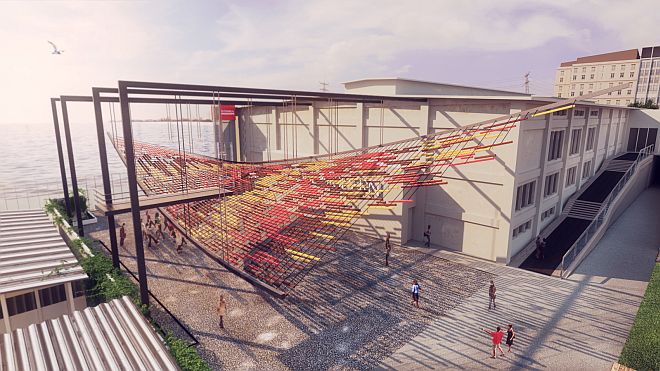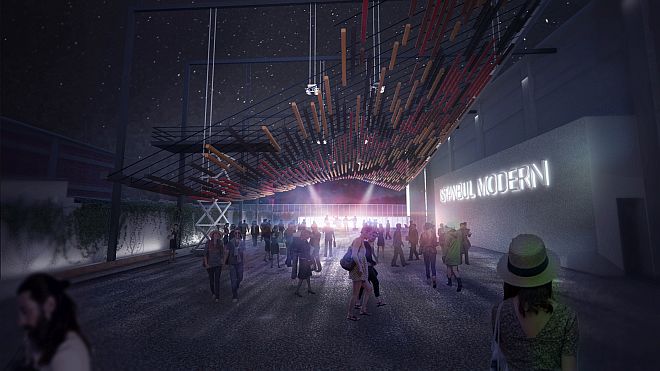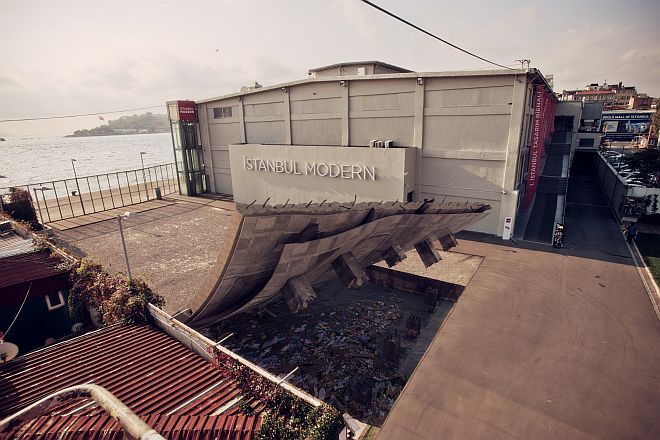SANATATAK IN ENGLISH
The first article in English at Sanatatak is Jesse Honsa’s interview with ONZ Architects (Onat Öktem and Zeynep Öktem)
Initiated by The Museum of Modern Art (MoMA), MoMA PS1, and Istanbul Modern, the Young Architects Program (YAP) provides emerging architecture practices with a platform for new, experimental ideas. Held biannually, one proposed installation is built in the courtyard of Istanbul Modern, with a special focus given to issues of sustainability, shading, and seating along the Bosphorus-affronting site.
ONZ Architects (Onat Öktem and Zeynep Öktem) were selected as one of five finalists for the 2013 YAP, and their project “Tearing The Ground” was exhibited at Istanbul Modern last year. The Ankara-based firm, founded in 2007, made waves with their unique proposal to shade the courtyard under a “carpet” made of recycled plastic debris from the Marmara Sea. An elegant solution in itself, the project confronts one of our world’s dire emergencies that requires attention.
Jesse Honsa: In your installation proposal for the Istanbul Modern, your animation plays a pivotal role, perhaps essential. Was an animation part of the competition requirements, or was it your own initiative?
ONZ: The video was not a competition requirement however we thought that it conveys the idea most efficiently. The gesture of tearing the ground and revealing what’s underneath was the idea that was the most exciting for us during the competition process so we thought a video would best show that gesture and the transition of the plastic marine litter to our flying carpet. The end work was very satisfying for us and is a keystone for our project. I must add that we also loved the music that we found for the video and kept singing it while we worked for the competition.
J.H.: The content of this animation has a narrative quality that goes beyond simply representing the proposal. You use excavation as a metaphor for what the project intends to do: expose people to the environmental pollution "swept under the carpet." Is the narrative video or the final construction more important?
ONZ: The competition site next to Istanbul Modern building is actually standing on pillars over the sea; so if you would really raise that ground you would be exposed to marine litter. This specificity of the site was the starting point for the project. Of course we do not intend to tear the actual ground but rather show people what they don’t see or realize beneath their feet. In a way we can say that the formal design took its shape from this idea. We also wanted to use the plastic waste as the main material for the construction to strengthen this awareness. Consequently the material itself; the repurposed plastic blocks fluctuating in the sky are the main reference to the narrative even if the visitors do not watch the video or read the explanations.
J.H.: Besides excavation, there is a second striking image in the video: the magic carpet of re-purposed plastic waste. Was there some type of tounge-in-cheek orientalism intended in this image?
ONZ: Actually it was what we intended. Being the first MOMA/YAP project in Turkey, we wanted the final image to have a touch of the distinctive character specific to these lands. To be honest there were times when we questioned if it was too much of orientalism but the final modernized form of the carpet was very intriguing and satisfying for us. We studied the undulating form of flying carpets and tried to deduct the specific form which gives the carpet the appearance of flying. This form was then modelled and the number and location of the plastic pieces were calculated with computational design.
J.H.: Could you describe the idea behind the construction of the piece?
ONZ: The project consists of plastic units that are made of plastic waste in the Marmara Sea. This plastic waste after being collected and sorted out by color would go through a process involving shredding, cleaning and fusing together under pressure and high temperature steam. There are no sorts of adhesives used in the process and the end material is lightweight, clean and cheap. They are also strong enough to be used as an alternative construction material.
As a result, the installation becomes a reflection of what is discarded into the sea, what the city produces as waste and all that waste that is beyond the recycling system.
As a reminder of the origin of the plastic units, the project interacts with the most valuable feature of the city: The Bosphorus. At night spotlights located on top of the structure creates a sea of shadows underneath the carpet. The spots are controlled according to the movements of the Bosporus. This leads to a variation of shadows mimicking the waves of the sea. Weather conditions play a key role in this alteration; a calm weather would steady the spots and create a slow and peaceful shadow, whereas a wavy day would end up with faster movements in the shadows.
J.H.: On ONZ’s facebook page you write as a description of the project "TEAR THE GROUND / EXPOSE THE TRUTH!" Sort of a revolutionary statement. Architects in Turkey, whether they like it or not, are certainly in the middle of some historic social changes taking place. As a young firm trying to establish yourself as something new against the status quo, do politics play an important role in your work?
ONZ: Architecture has always been in close contact with politics (smiles)
We believe a better world is attainable through architecture. That is why we embody the most suitable sustainable features in our designs, make academic researches on the subject and negotiate with authorities for a more respectful use of the earth’s resources. Our sensitivity for nature and meticulous design process have brought us many national and international architecture and urban design awards.
As ONZ Architects we also give great importance to sharing and promoting architectural culture so we curate and organize exhibitions and workshops with international contributors, under the name of “Creative Initiative”. We also work as part-time instructors and guest jury-members in prominent universities in Turkey.
J.H.: Your project asks for a society to produce less and waste less, yet we architects are constantly driven to produce, often by some internal creative impulse. How do you justify our own superfluous production? Aren’t we architects feeding a larger system of constant waste as we create so much digital and physical produce?
What would happen to the plastic rods and other materials once the installation was over?
ONZ: It is a very good question and thanks for asking. This is a subject that we as ONZ architects constantly discuss as well. Just the other day we were talking about the absurdity of a sustainable architecture competition requiring 6 printed A0’s to enter. We couldn’t change the requirements with that competition although we discussed with the authorities but maybe for the next one things could be different. I guess sustainability should not just stay as a popular term to embellish architectural projects but we architects should internalize the concept and try to put it into practice more and more.
As ONZ architects we are very concerned with preserving the natural environment when new architectural forms are required. While all of our designs fit in to the idea of ecological design, we also take interest in experimenting with new approaches and technology in the design medium.
We are in constant search for how to build with minimum harm to the environment. Our project “Green Mosque” received a Green Dot award this year. Similarly “Bird’s Nest,” another experimentation for sustainability, received awards in the USA. Our first objective right now is to raise consciousness about the subject among Turkish authorities and realize these projects.
As for the YAP Istanbul Modern installation; the plastic units after the installation were intended to be used to produce a living unit, to experiment on its performance for disaster housing. What was temporary would become permanent. And maybe fundamentally change the way we deal with plastic waste in the future. In Turkey many people are still living in tents after an earthquake that took place two years ago. As I said before these plastic bricks are strong, cheap and lightweight, the raw material can be found anywhere and also constitutes a major problem in terms of pollution. So why not use these for disaster housing? Our research about the subject continues although the installation didn’t get realized.
J.H.: Besides The MoMA Young Architects Program, what kind of work does ONZ do?
ONZ: ONZ Architects is a young innovative office, founded in 2007, based in Ankara-Turkey. As a multidisciplinary office, we create projects in various scales; from architecture to town planning and urban design. We believe that no architectural implementation is possible detached from its context. Our trans-disciplinary network increases our capability to enter complex conditions and move our understanding beyond the limits of geographical borders. In recent years ONZ Architects has won several awards in national and international architecture and urban design competitions.
We believe that we have an obligation, as architects to do our best to preserve the earth’s resources. That is why we prioritize environmentally conscious design and conduct academic studies on the subject. Our award winning projects in the USA, the “Green Mosque” and the “Bird’s Nest” incorporates the most suitable sustainable features to the architectural design.
We are very concerned with preserving the natural environment when new architectural forms are required. While all of our designs fit in to the idea of ecological design, we also take interest in experimenting with new approaches and technology in the design medium.
We believe our multidisciplinary way of work enables us a broad vision while making the process more intriguing and exciting. With this idea in mind and to broadly share and promote the architectural discipline, we have founded “Creative Initiative”; a young architects platform where we curate and organize exhibitions and workshops with international contributors and people from other design disciplines. The movement led by Creative Initiative shall expose that mere independent ideas may in fact be more significant than the product of the particular idea.




